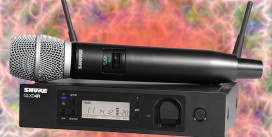Wireless mics typically use radio frequency to transmit the signal without using wires. They are powered by internal batteries in order to modulate the radio signal and send it to a receiver. Such receiver however, would still use short wires to output the signal further to an amp or mixer. There is a great variety of receivers using different modulation methods and basic preamp features such as active EQ, gain control, etc. Note, wireless mics have their own advantages and disadvantages, which are important to understand if you consider their use.
Advantages of wireless microphones
The first advantage that comes to mind is the freedom of movement. With a wireless mic, you can move around the stage freely and never have to worry about the tangling cables. Such microphone would even allow you to dance without stepping on the cable. The stepping itself is unlikely to cause any damage or noise but it often causes the connector to unplug, which is the least thing you want during your performance. Another advantage is that it brings a clean and simple, aesthetic look. In modern age, wireless technology is everywhere and it’s quite very trendy.
Wires by itself also tend to distort and add a degree of noise to the signal. The most obvious effect is called circumference. In this case, a wire basically serves an antenna that captures all kinds of different signals from the environment. Those signals are relatively weak but they are also amplified along with the microphone output and in the end may become quite significant. In theory, they may add any extraneous signals from radio broadcasts to GSM phones but most often, they appear as hissing and humming sounds caused by industrial net.
Apart from circumference, another less obvious wire disadvantage affects the clarity of the signal. I’ll bring an analogy with a proximity effect. In any directional microphone, different frequencies have different gain, so a change of the frequency can greatly affect the polar pattern. As the signal travels through a wire, different signal frequencies also do not behave the same way. They actually travel with different speed, which results in a smeared signal. To keep the long story short this may affect the very dynamics of the sound, making it less expressive and weak.
Disadvantages of wireless microphones
Wireless technology also brings a number of disadvantages that may limit its usage. Perhaps the most significant one is the use of batteries. Although there are plenty of different models that may keep it going for days, you just never know when it drains. Nothing is more annoying than a mic that runs out of charge, especially if you don’t have any replacement. Human factor also tends to play a lot, as people simply forget changing those batteries. Sometimes a battery gets poor contact with the connector inside microphone and results in the same symptoms just like if it was drained.
Although the use of wireless helps to eliminate some wire noise, radio frequencies tend to distort the signal in its own ways. This is very similar to what you get while watching the TV. If you have a poor performing antenna, the picture does get distorted and even good antennas can’t avoid a degree of distortion. Just like TVs though, some microphones use digital sampling, which can be compared to satellite TVs. In a satellite television, you get almost no distortion as long as the signal is clear. However, the signal has to undergo the digital sampling, which results in degrading of quality. In case with TVs, it can be observed as tiny square blocks and other sings of compression. In case with microphones, the digital sampling will downgrade the high-end specter. Very likely, you’ll not notice it, and yet it’s still there.
Aside from the distortion of the signal itself, wireless system also often tend to interfere with other wireless devices. For instance if you have two microphones that work in a similar frequency range, this will render their use inapplicable. Not only that, there are tons of radio signals everywhere in the environment and some of them may potentially interfere. This may result in any kinds of noises from white noise to different beeps and other weird sounds. Moreover, like any radio signal it can be easily ruined with a radio silencer. Any beginner radio engineer is able to make such device.
There is yet another disadvantage of wireless, which is a limited range of use. Typically those devices work within range of 30 meters, and although this figure may vary from model to model, higher coverage will likely result in higher cost and quicker battery draining. Talking about the cost, wireless systems are also significantly more expensive. Oftentimes you will find them about two to three times more expensive compared to equivalent XLR microphone models including the appropriate cables. Finally, just like cables, wireless systems also break and won’t always last forever.
Conclusion
To conclude the above, I would advise using wireless technology only when necessary. For TV shows or news reporters, they are certainly indispensable. The actors have to move around a lot and cannot afford being limited by wires. Even more so for the hidden lapel microphones that are clipped onto the clothes, as that would make no sense if they have been wired. For karaoke singing, this can also be useful, though expensive. You will likely want to move around as you entertain your guests and then pass the mic to someone else, so if you can afford spending 2-3 times more then it’s totally fine.
On the other hand, you will find XLR mics preferred much more for most live stages, for a number of reasons. First, it is the reliability. Second, it is simplicity, as the artist can simply replace for any other XLR mic without messing with back end. Finally, on most especially louder stages you can’t allow moving the mic. The mic position is often carefully chosen by sound engineer and any voluntary movement can possibly decrease its performance and even trigger a PA squeal. In this case, the most valuable wireless advantage – the freedom of movement becomes inapplicable. For studio recording you’ll never want the wireless either.








does leaving the receiver on and turning the transmitter (microphone) off still drain the batteries?
Nope, receiver is powered independently and so it has no effect on the mic’s battery.
Anything to say about Infra Red microphones. IR units. . Are they usually combination UHF and IR as a form of diversity feature or just IR.?
Never heard about IR mics actually, maybe it’s just a gimmick.
I don’t know when of if you’d see this comment. But hopefully I pray you see it on time.
I’ve got this single wireless mic it’s QFX 366, th3 receiver no longer exists.
and I wanted to know if its possible to connect this mic to a different receiver…?
I don’t have the money to purchase a replacement receiver, so wanted to know I’d I can get it connected to a different receiver…
Thanks in advance.
Hopefully you can catch me on whatsapp.